|
|
|
train to Los Angeles
Friday, March 3 2000
Because I expected to be getting up at 5am this morning, I went to bed early last night. Just before I fell asleep, I watched a little of the gameshow Who Wants to be a Millionaire. I'd read something about it over at Salon and was curious. I wanted to now if it really was, as I'd been led to believe, a gameshow for modern audiences. Whoah, after watching it, I have to admit that it is. Here are some of the features that make it so much more compelling than, say, a tired old gameshow like Jeopardy, which I almost never watch.
- None of that unnecessary 50s-style "you must answer with a question" bullshit.
- The music is dark and brooding, more like an ambient horror flick than anything else. It gives weight and significance to otherwise boring pauses that inevitably occur while the contestants think. Such music is a huge improvement over the behind-the-times jazz elevator music being used on older game shows.
- The fact that, for the vast bulk of the show, only one contestant plays at a time. This makes the contest intensely personal, whether you like or hate the contestant. Indeed, for the most part this give the viewer a chance to feel superior, since the contestant invariable falters on questions the viewer can answer.
- "Life lines" and other techniques allow the contestant to survive rough questions while involving us, the audience, to involve ourselves more in his or her life. The contestant is no longer from nowhere with nothing at stake; the or she is a real person with real parents. This feature has as its principle antecedent various aspects familiar from Michæl Feldman's comic radio gameshow, What D'Ya Know?.
I watched the complete rise and fall of a single contestant on tonight's Who Wants to be a Millionaire. He was real piece of work, perhaps the ugliest young man you'll ever see featured so prominently on broadcast television. His underdeveloped jaw beneath his cranium was no more remarkable a feature upon his neck than was his Adam's Apple, cursing him with a profound undershot. His cheek bones had the definition most commonly found on Idaho potatoes. His body was skinny and awkward and, though he claimed to be a College Junior, his voice had yet to completely make the transition to adulthood. I knew he was going down fast when he needed a lifeline to know which sign of the zodiac was represented by a goat, Virgo or Capricorn. It must have made a lot of people in the audience feel superior when the ugly girlfriendless dork surprisingly turned out to be stupid as well, only walking away with $1000.
The success of new gameshows such as Who Wants to be a Millionaire fits in nicely with a general theory I've been incubating about generations needing to have their own brands of commodities and services. As children, we grew up watching our parents playing along with Jeopardy, vacuuming with Hoover vacuum cleaners, and driving Buicks. But the music in Jeopardy wasn't our music, the questions weren't about anything we knew about, and the people had nothing in common with us. It wasn't our show and never became our show because we never started watching. Meanwhile, the Hoover vacuum cleaner eventually broke down and filled the room with dust every time it was used, again leaving bad associations. Same with the old Buick. Later on when we became adults, we wanted hip new things without all the bad associations of our childhoods. We wanted to vacuum with Dirt Devils, drive Saturns, and watch gameshows like Who Wants to be a Millionaire. We can call this "Gus' theory of generation brand loyalty instability."
This morning the alarm went off at 5am and Kim drove me down to the Santa Fe train station in downtown San Diego, where I caught the 6:15am Amtrak train to Los Angeles. I didn't really want to go to LA, but I had yet another job interview scheduled in Santa Monica, with the same company with whom I'd interviewed earlier in the week.
The train heading north was a spacious double-decker with not all that many passengers. The few it was carrying were a noisy bunch, though; a couple of hearty men nearby were exchanging and endless series of boring fishing stories. I was in the upstairs section with a window on the east side. The views were unexpectedly spectacular, especially up the unexpectedly agrarian Sorrento Valley which runs north and south just north of La Jolla and inland some miles from the ocean.
The most interesting part of the trip was the leg passing along the artificial concrete channel of the Los Angeles River through the south eastern sector of the city. Much of this area was in a state of semi-functional ruin, with rusty old factories somehow grinding out products behind broken windows and dented corrugated metal walls. Here and there, poking up like fresh young mushrooms through this older man-made layer was the rebar and fresh concrete of multiple interlacing pedestal-mounted freeway lanes (all in full compliance with stringent California earthquake readiness regulations). The most impressive spectacle along the river was the abundance of elaborate, meticulous graffiti, stretching endlessly on the concrete surfaces of the river, its abutments, and the pedestals of everything rising vertically from it. If nothing else, the graffiti was evidence of a vast nascent, untapped (and somewhat mischievous) graphic design talent in the surrounding neighborhoods.
Union Station in Los Angeles is a building just starting to pick up the funk of its years and the sheer volume of people having passed through it. The older white man at the information booth was dispensed the essential wisdom on where I needed to go to catch the Big Blue Bus to Santa Monica.
The bus driver had a hair trigger on the horn the whole way to Santa Monica. A large fragment of the trip actually went down the I-10, and though this was somewhat congested, the driver found his way through it as quickly as possible, even taking exits as a form of HOV lane around particularly gridlocked clumps of cars.
The interview, my second at this latest prospective employer, went very well again. Today I mostly met with a large group of community-types, the sort of people with whom I worked best at my last job. Since my prospective employer's website lacks many of the good community features that I built for my last employer, the community team seemed to be accepting me with enthusiasm and even what seemed like a sense of relief. This, in concert with a very rich cup of coffee, completely dispelled my nervousness and brought on my outgoing, jokingly talkative self. For example, regarding content tools for users, I summed up my semi-idealistic desire to empower users with the term "kumbya," a term that the other laughing used throughout the rest of the interview.
In addition to the various community people, there was also a developer present just in case matters became too technical. But he didn't have any serious questions for me at all. When asked by the others why he wasn't asking me questions like he usually does, he responded, "because usually we interview dumb people." I considered that high praise coming from a fellow developer (and even said so). Presumably this guy had looked at my sample code and at the applications I'd built and come away impressed. As someone who feels a little like an impostor in the world of programming, this is the sort of confirmation I've been psychologically craving for a long time. At my last job, you see, no matter how my talents grew and no matter how sophisticated my programming became, other developers there had a rather stale picture of my skills based on their first impressions, which many of them received back when I knew only the basics. Indeed, since much of my ancient code still runs the site, even new developers saw stuff I'd written that was unrepresentative of my skills. Coming to a new company with a proven track record from an old company, I can start with a set of new colleagues at the level I've attained through a year and a half of 60 hour weeks. Indeed, I'm sure that periodically leaving companies is essential for a developer if he really hopes to improve himself professionally. By the time I was through at my old company, I was probably spending more time running into glass ceilings than I was actually programming.
The next interview was a one-on-one with the manager of Human Resources. He asked me a few questions to probe how well I got along with others at my last job, but he didn't ask if I was fired. We also discussed salary requirements and benefits packages. He was a nice enough guy and again the interview went well.
The ride home to San Diego was the reverse of the ride up. Scarfing down a couple Carl's Jr. Famous Stars, I waited on Santa Monica Blvd. for the Los Angeles bus, and when it didn't show up for awhile, I stopped at an esoteric wine shop and picked up a $20 bottle of Bushmills Whiskey (the cheapest whiskey in the place) to enjoy on the long ride home.
The crowded bus to Los Angeles featured a good number of fringe characters and mental cases. There was this one long-haired bronze-faced homeless guy carrying two trash bags full of aluminum cans. Then there was a guy who looked like a thin Bill Cosby; he had a CD player and liked to play Peruvian music. Occasionally he lapsed into compulsively crossing himself Catholic-style.
I sipped a mix of whiskey and Dr. Pepper for the whole ride back to San Diego, occasionally snapping pictures. As we passed along the Los Angeles River, I saw homeless people milling about and hanging out. Many of them, it turns out, live in the concrete caves of the tributaries leading to the river. They hang out near the mouths of their caves, on the edge of the Los Angeles River itself, doing whatever it is that bums do all day. Seeing people living in these drainage structures simply confirms my notions of the adaptability of humans to their environment. Here they were, somehow able to live caveman lives in the heart of human-tamed civilization: a river flowing in a wide concrete ditch.
The view of San Diego from the tracks was a big disappointment after having been through Los Angeles. Most disappointing of all was the fact that all of San Diego's graffiti has been obsessively blotted out. A city that denies the expressions of its graffiti is hard place to experience freedom. No wonder the Gaslamp District of San Diego is so lame.
I walked from the San Diego Santa Fe train station to Kim's workplace, the V!ctoria Rose, but since I had an hour to kill, I hoped I'd run into a coffee shop. I didn't want to venture into the heart of downtown for fear of running across old colleagues, so I walked directly to the V!ctoria Rose. It says something about San Diego's downtown that within it there are absolutely no gathering places outside of the deliberate Schteveish pseudosophistication of the Gaslamp District.
[REDACTED]
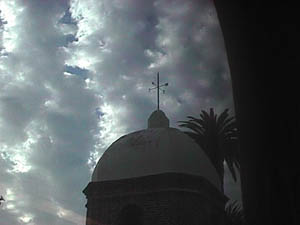
A Spanish-style tower in San Juan Capistrano.

Distant mountains to the east of agrarian fields near Irvine.
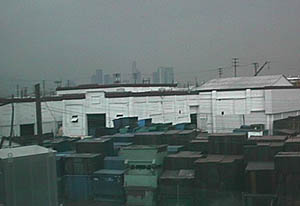
The few towers of downtown Los Angeles viewed through the haze above a lot full of dumpsters.
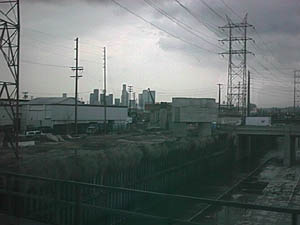
Downtown Los Angeles rising in the distance above a river bed of concrete.
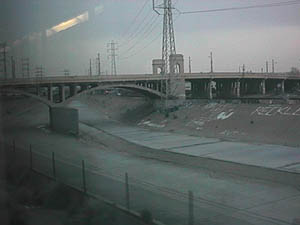
A bend in the manmade trench of the Los Angeles River.
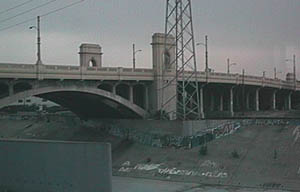
Ornate graffiti decorates the pedestals of most powerline towers along the Los Angeles River.
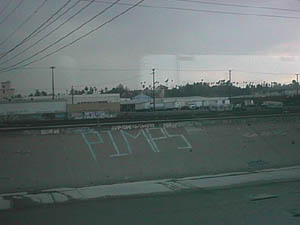
Tall-fonted graffiti in the Los Angeles River.
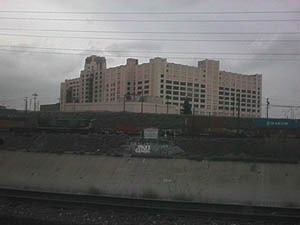
A Sears building rises over the river.
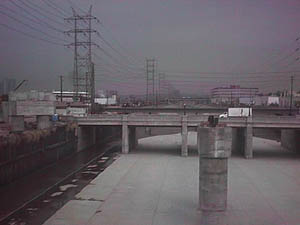
Electric wires and pedestals for new freeway lanes rise over the Los Angeles River.
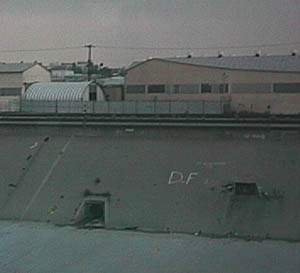
Bums frequently live in the mouths of dry tributaries feeding into the man-made channel of the Los Angeles River.
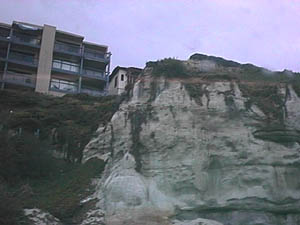
Buildings reach right to the cliff above the ocean in San Clemente.
For linking purposes this article's URL is:
http://asecular.com/blog.php?000303 feedback
previous | next |










